Reaching the top
PCX2, codename Midas 5, launched in April 1997 and PowerVR was promoting it with claims of 40% percent higher performance than main rival Voodoo Graphics. When testing specific parameters like polygonal throughput this may even be true. What is new in the chip? The first enhancement, much needed at the time, was reduced CPU load with hardwired floating to fixed point formatting and parameter scaling functions integrated into hardware setup. This is but one fraction of triangle setup- the rest of it still does CPU which is one of the reasons PCX2 remained hungry for FPU performance. Compositing 2D and 3D is now done on the chip, this may explain why I found PCX2 to be less sensitive to the primary video card. PowerVR claimed to implement bilinear texture filtering without speed penalty and by the results it really looks like they did. The clock is raised by 10% above PCX1 to 66 MHz. And at 30$ per chip, the cost of budget underdogs, PCX2 was even more aggressively priced than PCX1. If that is the case, why did Voodoo prevail?
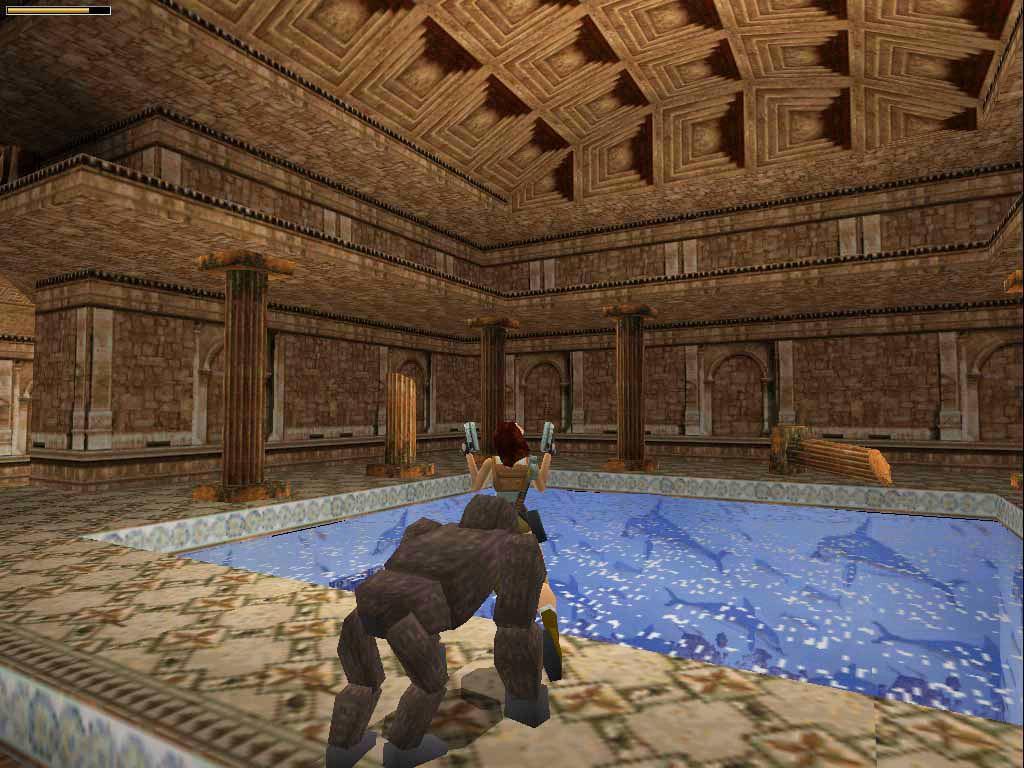 PCX2 rocking Tomb Raider at 1024x768 (click to enlarge).
PCX2 rocking Tomb Raider at 1024x768 (click to enlarge).
The card
In the test is VideoLogic's own and notoriously known Apocalypse 3Dx:
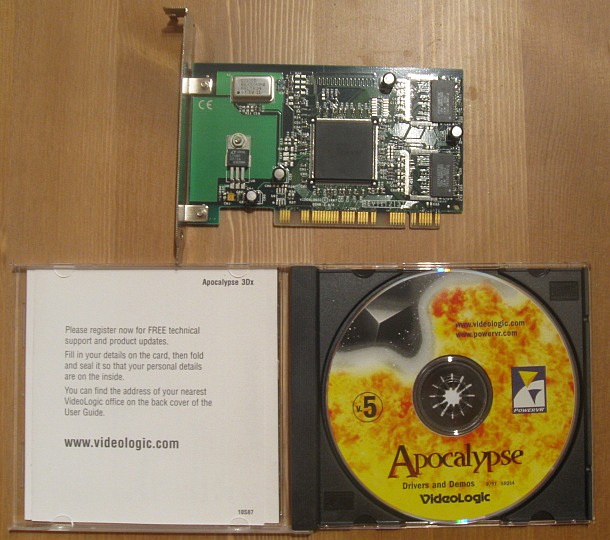 Looks just like first Apocalypse, the crystal is easiest way how to recognize PCX chip version.
Looks just like first Apocalypse, the crystal is easiest way how to recognize PCX chip version.

When you install Apocalypse drivers instead of generic ones, application profiles will appear in PowerVR tab. Those should help gamers extract some more compatibility and performance from PCX. Some accusation of cheating appeared back then, but I had little to no success improving my results.
While the 24-bit checkbox is gone from the control panel, true colors are still available.
PCX2 chip, just like cards, looks hardly any different from PCX1. NEC's naming looks hardly any different- μPD62011 over μPD62010. They are software and pin compatible, but new features were built in.
Architecture
Midas 5 is the last and most feature-rich of the Series 1 chips and PowerVR claimed 1.5-1.7 higher performance over Midas 4. Of course, infinite planes are still present, but this time I should concentrate on more general features. PCX2 remains quite dependent on CPU speed, because of tile sorting and it needs the equations of the sides of the polygons in a different format than output of D3D/OpenGL. SGL driver actually converts even more triangle information so that infinite planes engine can process them as convex objects. This allows performance optimization by conversion of triangles into multi-sided polygons. Come to think of it, Series 1 could have profited if quadratic acceleration succeeded. Triangles on same plane can share angle, texturing, shading, and alpha blending data. Additionally, only the first triangle of the polygon needs a back-face culling test, which is for Series 1 still done by CPU. More efficient geometry processing is enabled by own display list, compressing geometry into polygon meshes reducing data duplication. PCX2 geometry muscle can sustain ~500k polygons per second with a theoretical peak rate three times higher. Additionally, PCX2 has its registers to store pointers to parameters in the main memory. After triangle setup hidden surface removal is applied, rejecting hidden polygons from further processing. Finally, the data gets to the rendering core, made of 32 processing elements in parallel calculating 32 pixels each. Loopback is needed for translucent/multitextured pixels. The accuracy of this accumulation is finally increased to fit the expectations of the time. PCX requires software ordering of translucent objects, to ensure color of the most distant triangle will be available for blending with a closer one. Texturing and shading are provided by the TSP, integrating 4 kB cache and beefed up to sustain 40 bilineary filtered pixels per second with Pentium 200 MMX.
PowerVR came first with consumer accelerator daring to claim Phong shading ability, though I did not see more than specular highlights with environment mapping. However, texturing is less ambitious. There is a big catch with the bilinear filter because it is applied uniformly for the whole frame in an all-or-nothing fashion. Texture formats are still limited to the power of two squares from 32×32 to 256×256. Also, color resolutions remained at 332 for eight bits, and 5550 (the sixteenth bit is reserved) or 4444. Not much hope for nice green grass there. On the other hand, before shading calculations, textures are converted into 24-bit colors. Both PCX chips support three level LOD. PCX2 finally made its fogging compatible with Direct3d.
Combining the output
To further offload host system the masking of 2D output is now managed in hardware, unlike the first PCX. Once on-chip tile buffer is filled with final pixel colors, it is dumped to the frame buffer of primary card. This creates extra demand for bandwidth of PCI and memory of the primary card, which led to small performance loss compared to Voodoo-like cabling or all-in-one cards. PCX2 supports 66 MHz PCI operation, but this mode was never really supported by motherboards for home computers. VideoLogic teamed up with Tseng Labs and created Apocalypse 5D. Combining 128-bit MDRAM ET6100 with PCX2 on a single card ensured minimal limits for PowerVR's rendering.
Gaming experience
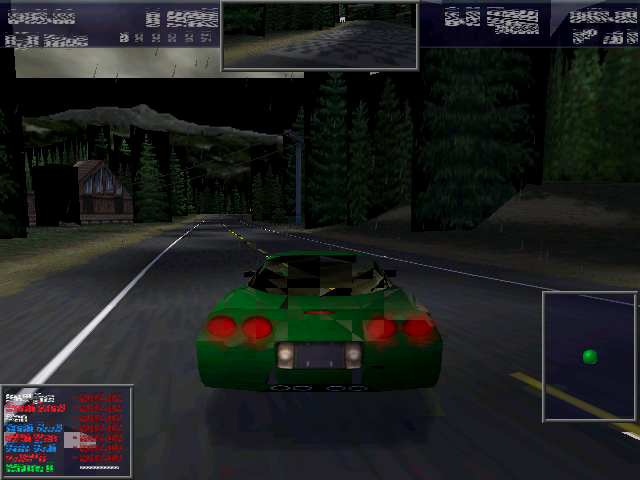 Uh, what is happening to my polygons.
Uh, what is happening to my polygons.
PCX2 shows how few important improvements can make gaming experience a whole lot better. Performance in many titles jumped on average by a good margin, though not evenly across all games. And there are not many titles left that would refuse to work. As said before the bilinear filter of PCX2 is all or nothing, and d3d driver selects a mode by the first triangle of the scene. Thus, some textures that should are not filtered (Battlezone), and some which shouldn't be to avoid blur (like HUD in LoL2) are. Plus the filter itself is not of very high quality and some MIP transitions are very disruptive with different amounts of bilinear "blur". Still, much better than blocky magnified textures. Nothing has been done about texture blending operations though. Expect similar artifacts and color banding as with PCX1, I will not repeat them here. Considering how few blending modes PCX chips offer I would dare to say that drivers achieved maximum. On the bright side, vertex fog is working. Depth artifacts in CartX are replaced with less disruptive ones. Dynamic lighting in Quake is fixed but static one still suffers from blockiness. MDK d3d was still hard to crack, screen flashes are blinding and textures disappearing. But the game got SGL patch anyway.
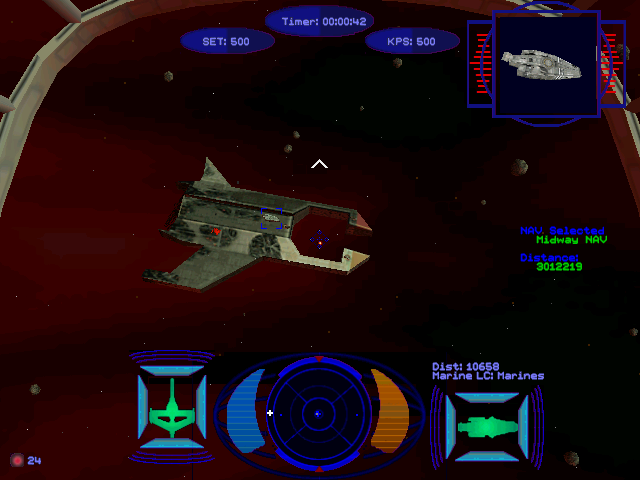 Filtering is much welcome, but other problems remain. Look at that banding on red space.
View PCX screenshots
Filtering is much welcome, but other problems remain. Look at that banding on red space.
View PCX screenshots
Results
Finally, how much faster it is? Sometimes the jump is significant but not guaranteed. Look at Forsaken for example. Please remember only Tomb Raider is using proprietary renderer and its result is from faster single buffered mode.
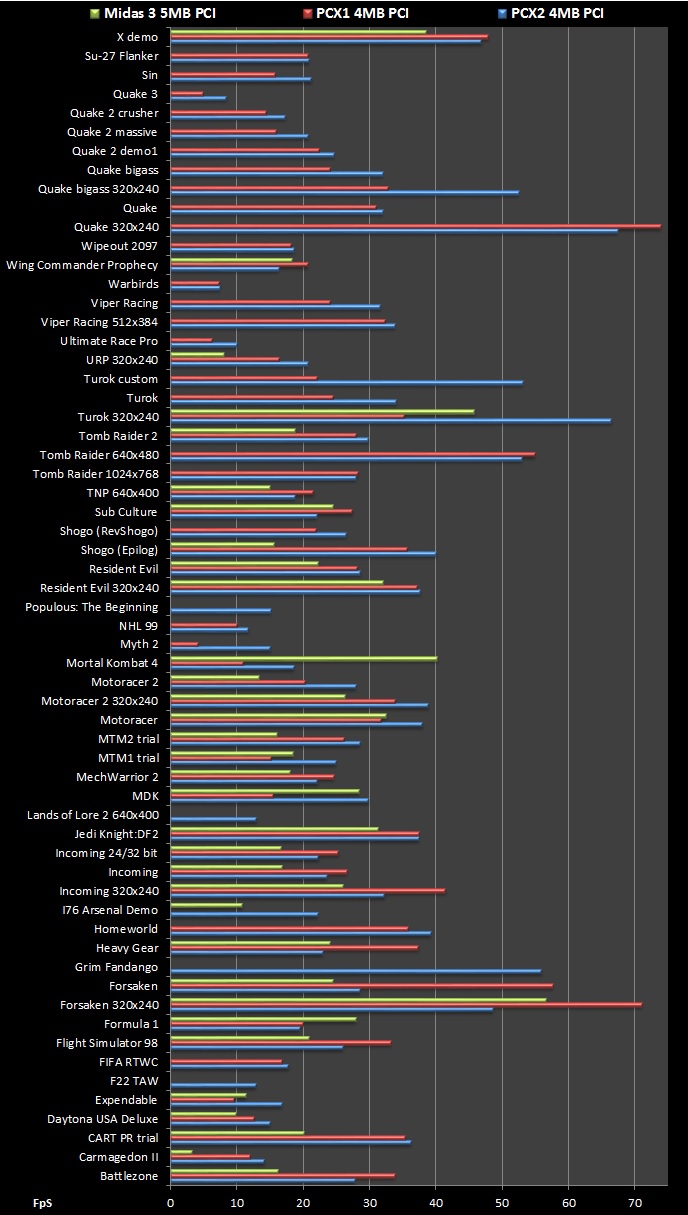
Overall PCX2 outperforms PCX1 by 20%. The difference in minimal framerate is even lower at 13%. Both PCX chips appear to be from the infrequent kind of architectures limited by other factors than fillrates.
Rest of the story
After PCX2 release came a new clash of 3dfx and PowerVR over graphics chip for a new console of Sega. NEC/VideoLogic famously won with their new design, shocking many PC players certain of 3dfx superiority. And the arrival to desktop expected after Voodoo2 launch promised a big challenge to the 3dfx craze. But silly those who would wait for the second generation. While NEC's manufacturing capabilities could not satisfy Dreamcast alone, VideoLogic was making only minor tweaks to the PC core, slowly mastering the new 250 nm process and waiting for free capacity. 3D add-on board was canceled, which was probably the right decision since the whole market switched to complete solution by that time. After one of the longest delay of 3D chip ever the desktop product named Neon 250 finally launched in the middle of 1999 and of course performance was so last year. Judging by rareness of the card it probably was not worth releasing after such delay. Second generation PowerVR with full floating-point geometry and texture setup engine put CPU demand in line with other solutions. Well-aligned with DirectX and equipped with capable 2d engine Neon 250 could have kept PowerVR in the spotlight should it arrive sooner. Rarely used infinite planes were dropped, but Neon 250 had other extras like a programmable processor in front of rendering and texture compression. VideoLogic reorganized and changed its name to Imagination Technologies and continued working on the third generation. NEC left the PowerVR boat, but a new manufacturing and marketing partner was already signed. ST Microelectronics took that opportunity and delivered new PowerVR product at the beginning of the year 2000 and received a lot warmer welcome. It was a dual pipeline deferred rendering architecture named Kyro. Having the tile cache on-chip played well for some new techniques. Kyro maxed out single pass texture layers and processed super-sample antialiasing without higher memory usage. Also, stencil buffer operations were extremely fast thanks to tiles. Because of very low frequency Kyro was a budget product, but Kyro II with a big clock bump became one of the top performers. Only the absence of Transform and Lighting was severe hardware deficiency. This was to be addressed in new four pixel pipeline core, but ST Micro decided to end its video chip manufacturing early in 2002. PowerVR cards had to face limited distribution and quirks of tiled rendering often required tweaking which only technojunkies did not mind. When properly executed some chips showed big advantages of deferred rendering and engineering talent of VideoLogic crew. Despite that Kyro sales were not so good, the fourth series canceled and the PC market was abandoned. The fifth series of PowerVR products targeted mobile devices and there they finally achieved big success. The deferred tiling doing a lot of memory operations on-chip shines within space and power consumption constraints. Imagination Technologies is to my knowledge doing great in this rapidly growing market. So good that some of us are still keeping hopes for PowerVR getting back to PC in any form.